AMD Makes Zen 3 Official: Ryzen 5000 Promises 19% Better IPC, 1080p Gaming Dominance
More 7nm nails in Intel's 14nm coffin.
Undisputed no-compromise dominance of the desktop PC market. That was AMD's long-term goal when it first began working on the Zen architecture nine years ago, and it took an unrelenting cadence of optimizations to realize that goal. AMD claims it has finally achieved that ambitious goal with the 7nm Ryzen 5000 processors that come with the Zen 3 microarchitecture. AMD says the Ryzen 5000 processors finally beat Intel in its last bastion — 1080p gaming — while maintaining Ryzen's existing lead in basically every other metric. The four new Ryzen 5000 models, which stretch from the $299 Ryzen 5 5600X up to the $799 Ryzen 9 5950X, arrive at retail on November 5th.
AMD touts its Zen 3 chips as having market-leading single-threaded performance, which comes courtesy of an overall 19% uplift to IPC (instruction per cycle) throughput. Combined with the optimized 7nm process that wrings out a 4.9 GHz boost from the flagship Ryzen 5000 'Vermeer' chips, it looks like AMD has finally swung the pendulum entirely in its favor. If AMD's benchmarks prove true in our testing, we'll have a new king at the top of the CPU benchmarks hierarchy and will be making changes to our list of Best CPUs soon.
AMD says it took a ground-up redesign of the Zen microarchitecture (we'll cover the details below) to deliver the big IPC gains, and pairing that with higher peak clock speeds delivers stunning performance improvements over AMD's previous-gen Ryzen models, not to mention Intel's Comet Lake chips.
AMD claims the Ryzen 5000 chips are now faster than Intel in gaming, single-threaded, and multi-threaded performance while also providing leading performance-per-dollar and up to 2.8X better power efficiency than Comet Lake. That covers all the bases, and the chips also offer backward compatibility with existing 500- and 400-series chipsets, meaning they'll offer a relatively inexpensive path for drop-in upgraders.
The pay off for Ryzen upgraders? AMD says you'll get an average of 26% more performance in gaming with the Ryzen 9 5900X over the Ryzen 3900X, along with improved performance in both single- and multi-threaded apps. Naturally, that will vary by game and application, but we have AMD's benchmarks below to give you an idea of what Zen 3's performance looks like.
Before we jump into the deep-dive details, here's the quick overview of the chips AMD announced today:
| Zen 3 Ryzen 5000 Processors | RCP (MSRP) | Cores/Threads | Base/Boost Freq. | TDP | L3 Cache |
|---|---|---|---|---|---|
| Ryzen 9 5950X | $799 | 16 / 32 | 3.4 / 4.9 GHz | 105W | 64MB (2x32) |
| Ryzen 9 5900X | $549 | 12 / 24 | 3.7 / 4.8 GHz | 105W | 64MB (2x32) |
| Ryzen 7 5800X | $449 | 8 / 16 | 3.8 / 4.7 GHz | 105W | 32MB (2x16) |
| Ryzen 5 5600X | $299 | 6 / 12 | 3.7 / 4.6 GHz | 65W | 32MB (2x16) |
AMD's assault begins with the beastly 16-core 32-thread Ryzen 9 5950X that will retail for $799. This chip boosts up to 4.9 GHz, has 64MB of unified L3 cache, and a 105W TDP rating. AMD says this chip is faster than Intel's 10-core Core i9-10900K in pretty much everything, which isn't surprising — Intel has no equivalent for the mainstream desktop.
Get Tom's Hardware's best news and in-depth reviews, straight to your inbox.
The $549 Ryzen 9 5900X slots in as the more mainstream contender, at least by AMD's rather extreme definition of 'mainstream,' with 12 cores and 24 threads that boost up to 4.8 GHz. AMD says this chip beats the 10900K by even more impressive margins in gaming. Further down the stack, we find the 8C/16T Ryzen 7 5800X for $449 and the 6C/12T Ryzen 5 5600X for $299.
Below we'll dive deeper on all these chips and how they stack up against Intel, including in AMD's benchmarks. First, here's the TLDR on Zen 3 Ryzen 5000 chips:
- 1080p gaming performance leadership
- Same optimized 7nm process as Ryzen XT models
- Zen 3 microarchitecture delivers 19% IPC improvement
- 24% gen-on-gen power efficiency improvement — 2.8X better than 10900K
- Higher peak frequencies for most models — 4.9 GHz on Ryzen 9 5950X
- Lower base frequency for all models, offset by increased IPC
- L3 cache now unified in a single 32MB cluster for each eight-core chiplet (CCD)
- Higher pricing across the stack (~$50)
- No bundled cooler with Ryzen 9 and Ryzen 7 models
- Drop-in compatible with the AM4 socket
- No new chipset/motherboards launched
- Current-gen 500-series motherboards work now (caveats below)
- Beta support for 400-series motherboards begins in January 2021
- All Zen 3 desktop, mobile, and APU chips will carry Ryzen 5000 branding
- Same 142W maximum power for AM4 socket as previous-gen
- Same 12nm GlobalFoundries I/O Die (IOD)
Intel is stuck with its Comet Lake chips for five long months to try to fend off the Ryzen 5000 lineup until Rocket Lake arrives in Q1 2021, which doesn't bode well. AMD has already chomped away at Intel's desktop PC market share with the previous-gen Ryzen 3000 chips, and that was before AMD could lay claim to the fastest gaming CPUs.
As odd as it sounds, Intel may have one hidden advantage — pricing. AMD now positions Ryzen as the premium brand and says it has the benchmarks to prove it. As a result, AMD has pushed pricing up by $50 across the stack compared to its Ryzen XT models. However, the XT family doesn't really represent AMD's best value chips; its own Ryzen 3000 series, which comes at much lower price points, holds that crown.
In either case, Intel's Comet Lake chips now have comparatively lower price points than AMD's Ryzen 5000 lineup. However, AMD says it still maintains the performance-per-dollar lead and shared some data to back it up. As usual, we won't know the full story until the chips land in our labs. That obviously won't be long — AMD says the full roster of Ryzen 5000 chips will be available at retail on November 5.
AMD Ryzen 5000 Pricing, Specifications, and Release Date
Ryzen 9 5950X Specifications
As mentioned above, the $799 Ryzen 9 5950X slots in as AMD's halo product for the mainstream desktop. The 5950X has a 3.4 GHz base frequency, a 300 MHz reduction compared to the 3950X, and a 4.9 GHz Precision Boost frequency — a 100 MHz increase that falls just shy of the elusive 5.0 GHz.
AMD already owns the upper end of the mainstream desktop market when it comes to multithreaded performance, with the previous-gen $749 Ryzen 9 3950X that also comes with 16 cores and 32 threads. AMD's 5950X is even faster, so the company pushed pricing up by $50. Intel doesn't have an answer for the 5950X on its mainstream platforms — it already can't contend with the Ryzen 9 3950X.
Intel does have a dark horse, however, that comes in the form of the Core i9-10980XE. This 18C/36T chip now retails around $815 but requires a pricey HEDT motherboard and quad-channel memory. Even with the far-below-MSRP pricing that comes as a byproduct of its woefully inadequate performance compared to Threadripper 3000 chips, we don't see the 10980XE as a serious contender for the 5950X due to the reasons listed here.
| Zen 3 Ryzen 5000 Processors | RCP (MSRP) | Cores/Threads | Base/Boost Freq. | TDP | L3 Cache |
|---|---|---|---|---|---|
| Ryzen 9 5950X | $799 | 16 / 32 | 3.4 / 4.9 | 105W | 64MB (2x32) |
| Core i9-10980XE | $815 (retail) | 18 / 36 | 3.0 / 4.8 | 165W | 24.75MB |
| Ryzen 9 3950X | $749 | 16 / 32 | 3.5 / 4.7 | 105W | 64MB (4x16) |
| Ryzen 9 5900X | $549 | 12 / 24 | 3.7 / 4.8 | 105W | 64MB (2x32) |
| Core i9-10900K / F | $488 - $472 | 10 / 20 | 3.7 / 5.3 | 125W | 20MB |
| Ryzen 9 3900XT | $499 | 12 / 24 | 3.9 / 4.7 | 105W | 64MB (4x16) |
| Ryzen 7 5800X | $449 | 8 / 16 | 3.8 / 4.7 | 105W | 32MB (2x16) |
| Core i9-10850K | $453 | 10 / 20 | 3.6 / 5.2 | 95W | 20MB |
| Core i7-10700K / F | $374 - $349 | 8 / 16 | 3.8 / 5.1 | 125W | 16MB |
| Ryzen 7 3800XT | $399 | 8 / 16 | 3.9 / 4.7 | 105W | 32MB (2x16) |
| Ryzen 5 5600X | $299 | 6 / 12 | 3.7 / 4.6 | 65W | 32MB (2x16) |
| Core i5-10600K / F | $262 - $237 | 6 / 12 | 4.1 / 4.8 | 125W | 12MB |
| Ryzen 5 3600XT | $249 | 6 / 12 | 3.8 / 4.5 | 95W | 32MB (2x16) |
Ryzen 9 5900X Specifications
The 12-core 24-thread $549 Ryzen 9 5900X comes with a $50 markup over the previous-gen 3900XT. The chips' base frequency declines 200 MHz compared to the 3900XT, but the boost frequency reaches 4.8 GHz (a 100 MHz increase). Meanwhile, Intel's 10-core 20-thread Core i9-10900K slots in for $60 less than the 5900X ($77 less if you choose to go with the graphics-less F-series model).
If all you care about is gaming, Intel's $453 Core i9-10850K also slots into this bracket. The 10850K offers essentially the same performance as the pricier 10900K in gaming but weighs in at $96 less than the 5900X. Let's not forget that AMD claims the 5900X is faster in gaming than either of those Intel chips, though, and even faster in applications. We'll get to those benchmarks shortly.
Ryzen 7 5800X Specifications
The $449 Ryzen 7 5800X comes with eight cores and 16 threads, just like its previous-gen Ryzen 7 3800XT counterpart, but again comes with a $50 markup. The chip sees a 100 MHz lower base clock than the 3800XT but has the same 4.7 GHz boost. Given the price point, the Core i9-10850K also competes here with similar pricing to the 5800X, while the Core i7-10700K is ~$100 less. That sounds about right, as the Core i7-10700K failed to make a convincing case against the previous-gen Ryzen chips, and we don't expect that to change if the 5800X matches or exceeds its performance.
Ryzen 5 5600X Specifications
Wrapping up the list, the 6-core 12-thread $299 Ryzen 5 5600X's Base clocks come in at 100 MHz less than the 3600XT, while boosts are 100 MHz higher at 4.6 GHz. AMD's previous-gen 6C/12T Ryzen 5 3600XT had a 95W TDP, but AMD dialed that back to 65W with the 5600X.
We see a broad trend of lower base frequencies for the Ryzen 5000 series compared to the previous-gen Ryzen 3000, but that isn't too surprising considering the much higher performance-per-watt that we'll outline below. AMD obviously leans on its improved IPC rather than raw clock speeds, thus falling into a more efficient spot on the frequency/voltage curve. The Ryzen 5 5600X is the best example of that — despite only a slight reduction to the base frequency, the chip drops to a 65W TDP envelope compared to its predecessor's 95W. That's impressive. We also don't know precisely how the chips will behave in regards to boost clocks, but traditionally the base clocks are far below what you'll see in any real-world scenarios.
What's not as impressive? AMD has continued with the precedent it set with its Ryzen XT series: Bundled coolers no longer come with processors with a TDP higher than 65W. That means the Ryzen 5 5600X will be the only Ryzen 5000 chip announced today to come with a cooler in the box. AMD said it decided to forgo bundled coolers in higher-TDP models largely because it believes most enthusiasts shopping in those price ranges use custom cooling anyway. We also imagine AMD still specs a 280mm (or greater) AIO liquid cooler for the Ryzen 9 and 7 chips, which significantly adds to the pricing. We're following up for more detail.
As before, we expect AMD to only guarantee its boost frequencies on a single core, and all-core boosts will vary based on the cooling solution, power delivery, and motherboard BIOS. The chips continue to expose 20 lanes of PCIe 4.0 to the user and stick with DDR4-3200 memory as the base spec. We're told that memory overclocking capabilities remain the same as we see with the Ryzen XT models, so AMD hasn't changed its guidance on that front.
AMD Zen 3 Ryzen 5000 Performance Benchmarks and Comparisons
AMD Ryzen 9 5900X Gaming and Application Performance Benchmarks
Before we get into the benchmarks, a quick reminder about vendor-provided benchmarks: AMD provided these benchmarks, and like all benchmarks provided by any company, they could be (and probably are) heavily skewed toward games and applications that cast the company's products in the best light.
There's also the possibility of uneven test platform configurations. Be advised that AMD tested all processors, both the Ryzen 5000 and Intel models, with memory set at DDR4-3600. For reference, DDR4-3200 is the stock configuration for the AMD processors, and DDR4-2933 is stock for the Core i9-10900K. AMD also used a Noctua NH-D15s, a high-end air cooler, for all tested platforms (which is fine), and an Nvidia GeForce 2080 Ti. (It probably couldn't buy a GeForce RTX 3080 or GeForce RTX 3090 either.)
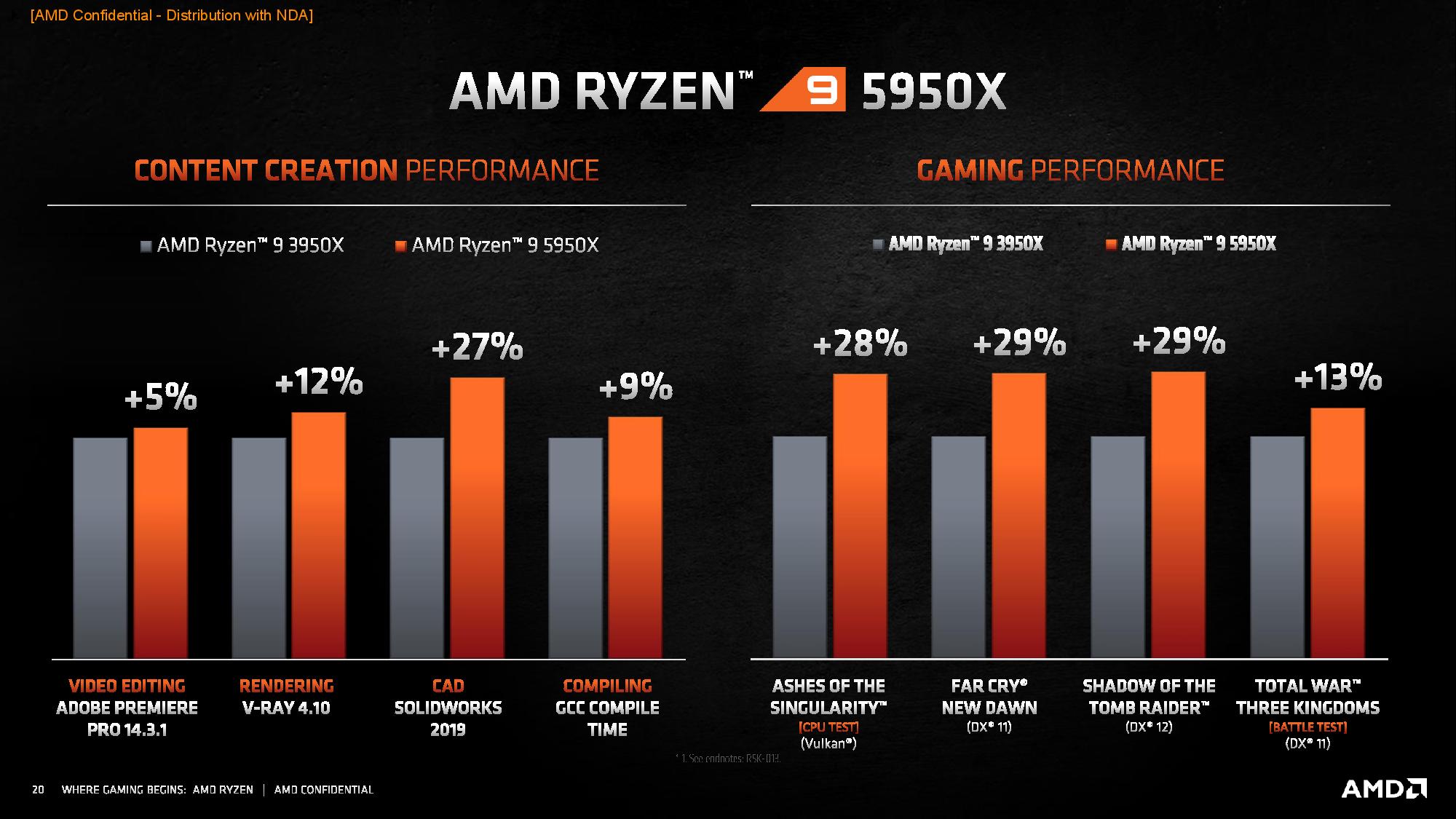
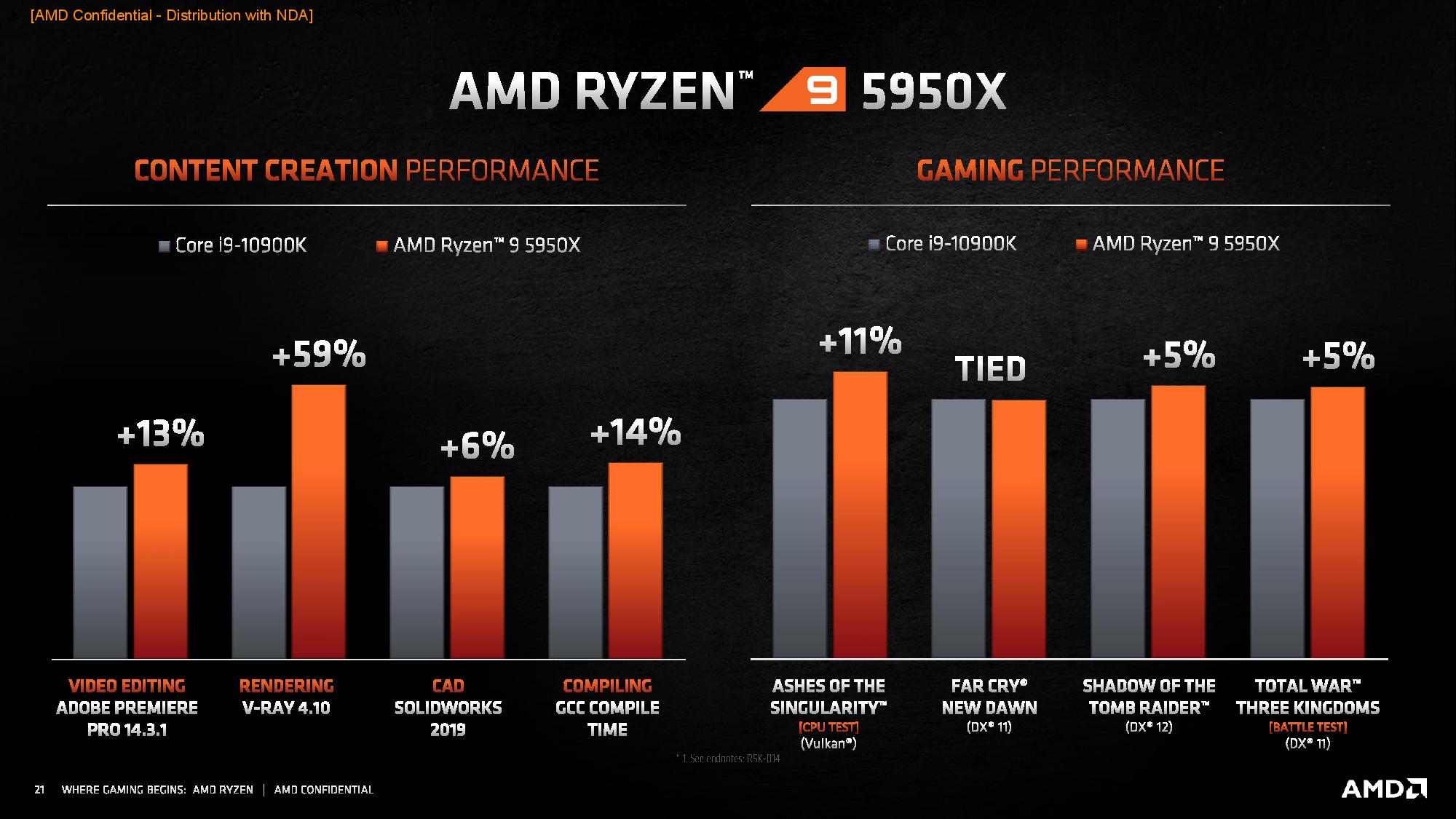
What does the $799 Ryzen 9 5950X's 16 cores and 32 threads get you? The first slide shows AMD's 5950X against the previous-gen Ryzen 9 3950X and outlines 20%+ performance gains in the tested games, though it does vary by title. AMD also says the chip scores 640 points in the single-threaded Cinebench R20 benchmark, which is much higher than the Core i9-1900K's 544 points.
The content creation portion shows the 5950X notching solid gains in lightly-threaded apps, like CAD, Adobe Premier, and compilation. In contrast, the performance gains in the heavily-threaded V-Ray application are a bit more muted. AMD says its processors still have to abide by the 142W power limit, which naturally reduces performance gains in heavily-threaded applications — but do note those performance gains are at the same power consumption, which denotes higher efficiency per watt. It will be interesting to see how that looks when we lift the power limits in our review.
The second slide shows the 5950X against the Intel Core i9-10900K in a selection of games and applications. The tested titles show what is basically a dead heat with the 10900K, but the Ryzen 9 5900X below is the faster gaming chip, so you'll see bigger deltas over the Core i9-10900K in that testing. We see strong performance gains over the 10900K in the suite of tested application benchmarks, which tracks well with our expectations.
Of course, with the RTX 2080 Ti, it could be the main bottleneck even at 1080p ultra. We joked about AMD not having RTX 3080 or RTX 3090 testing results, but in all seriousness, anyone upgrading to Zen 3 for gaming purposes is likely eyeing Nvidia's Ampere or AMD's Big Navi as well. That's something we'll be testing once we have hardware in our labs.
AMD Ryzen 9 5900X Gaming and Application Performance Benchmarks
AMD bills the Ryzen 9 5900X as the fastest gaming CPU on the market, which it says it measured from the average fps from 40 PC games at 1920x1080 with high fidelity settings. Due to the nature of today's games, much of that uplift comes from the IPC and frequency improvements that boost performance in lightly-threaded workloads.
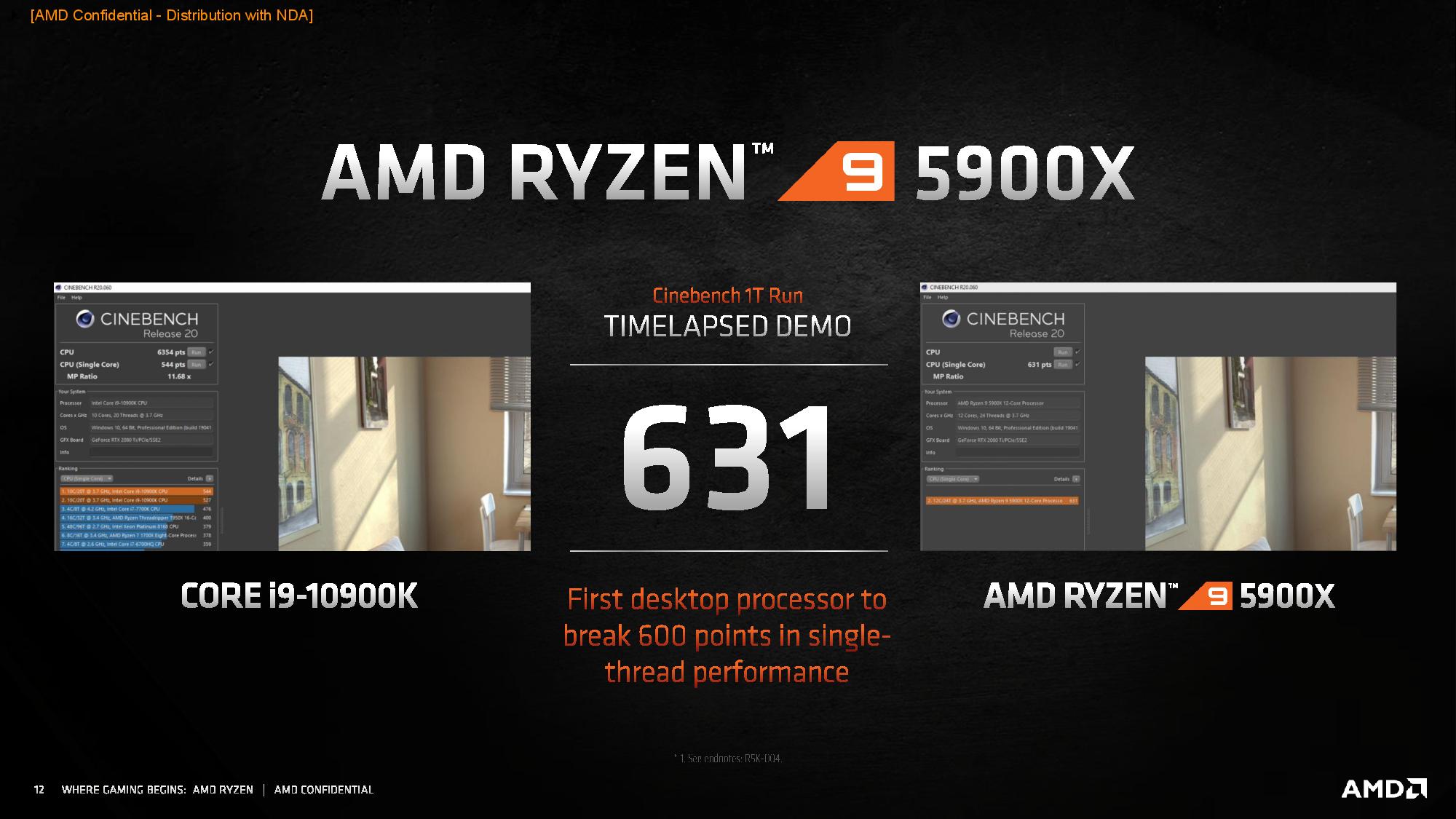
As such, here's a quick look at the improvement in AMD's favorite single-threaded benchmark, Cinebench R20. Note: This test is extremely favorable to AMD's Zen microarchitecture.
AMD scored 631 points with the Ryzen 9 5950X, while it measured the Core i9-10900K at 544 points. That works out to an outstanding 16% advantage for the Ryzen 9 5900X, but bear in mind this occurs in a single workload. As we know, performance varies with different types of applications. For reference, we scored 535 points with the 10900K in the same test, albeit obviously with a different test platform and conditions.
AMD didn't share the Ryzen 9 5900X's multi-threaded CineBench score, but measured the Core i9-10900K at 6,354 points. That's close enough to call a tie with our measurement of 6,356 points.
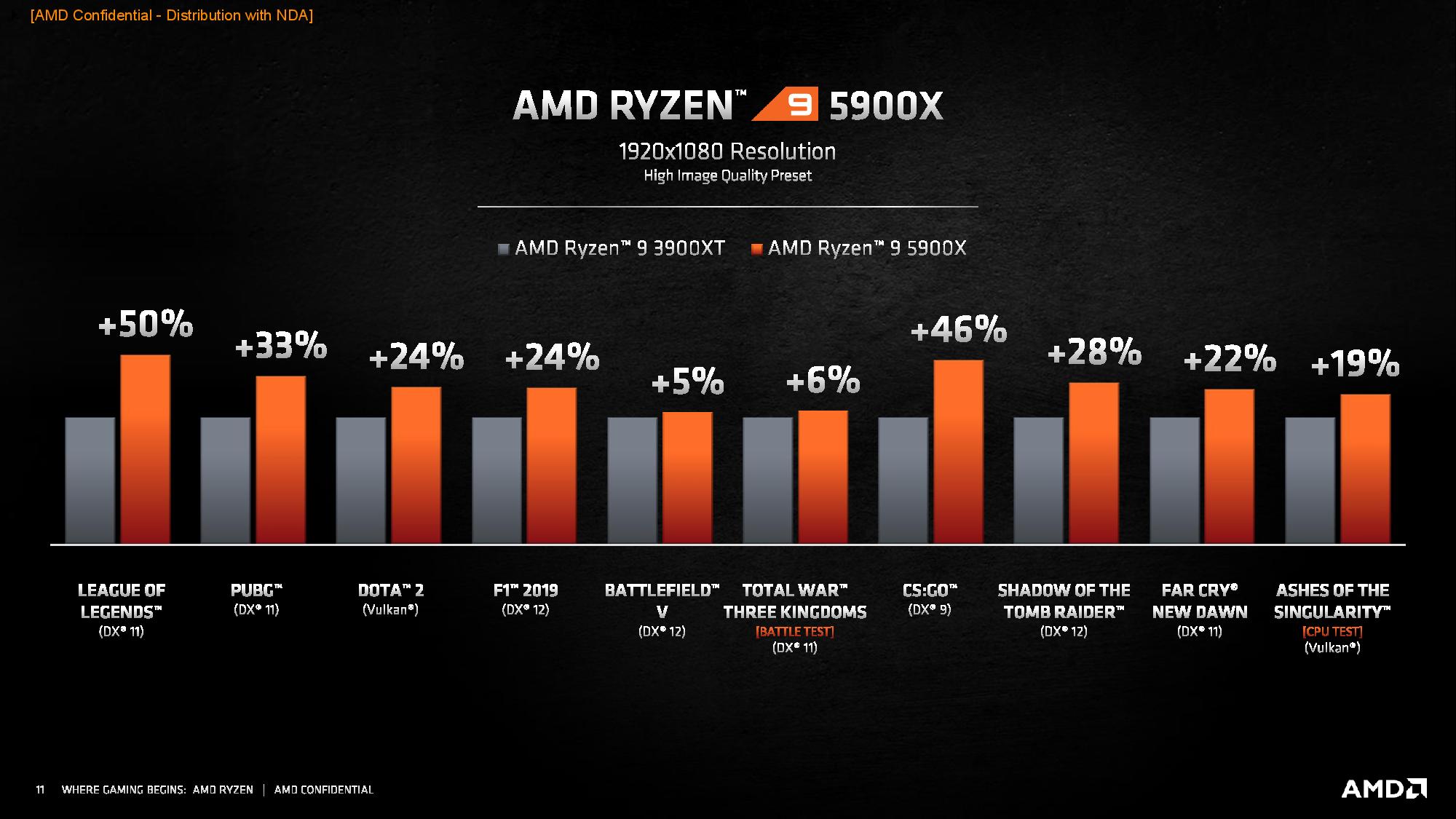
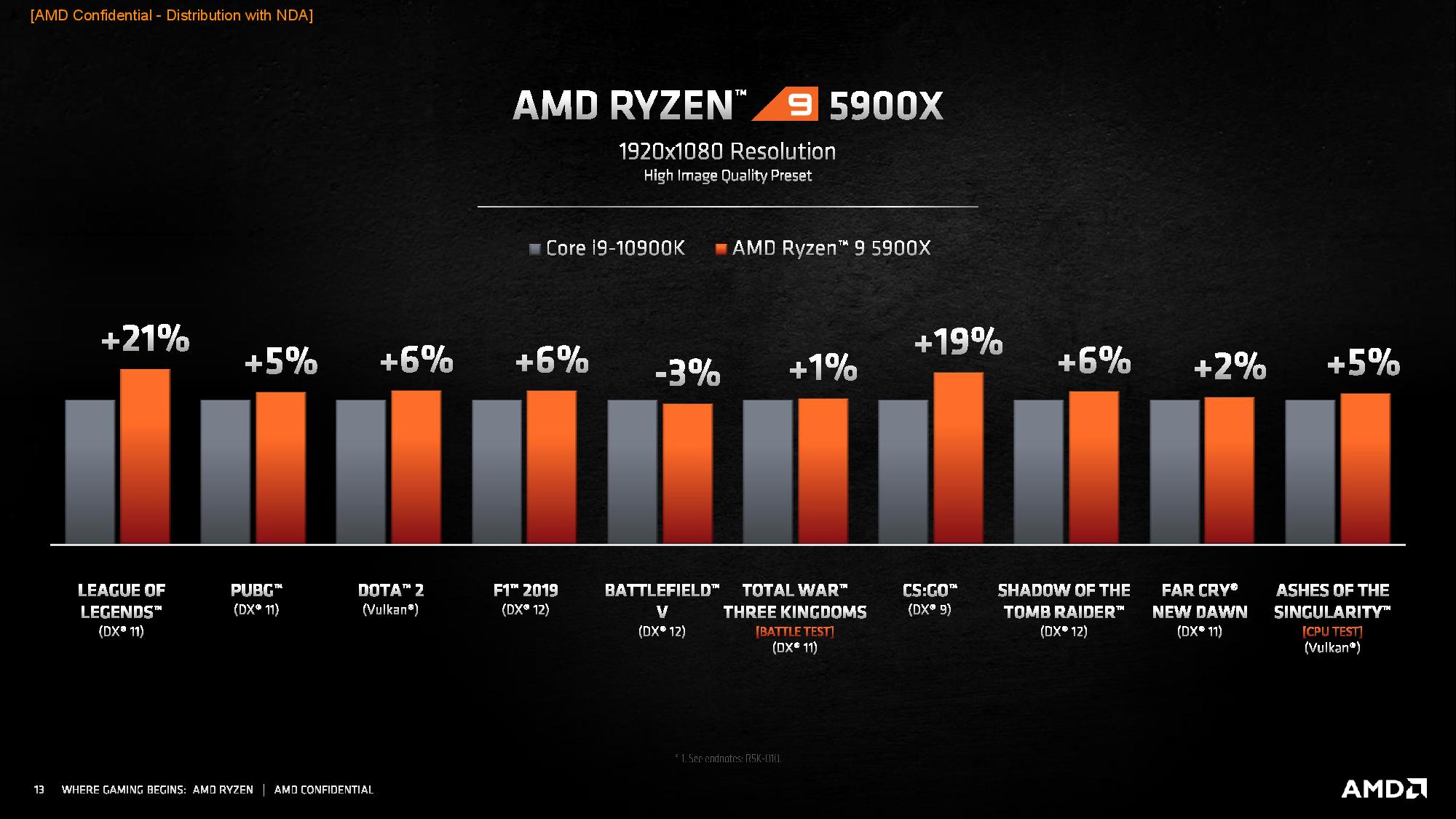
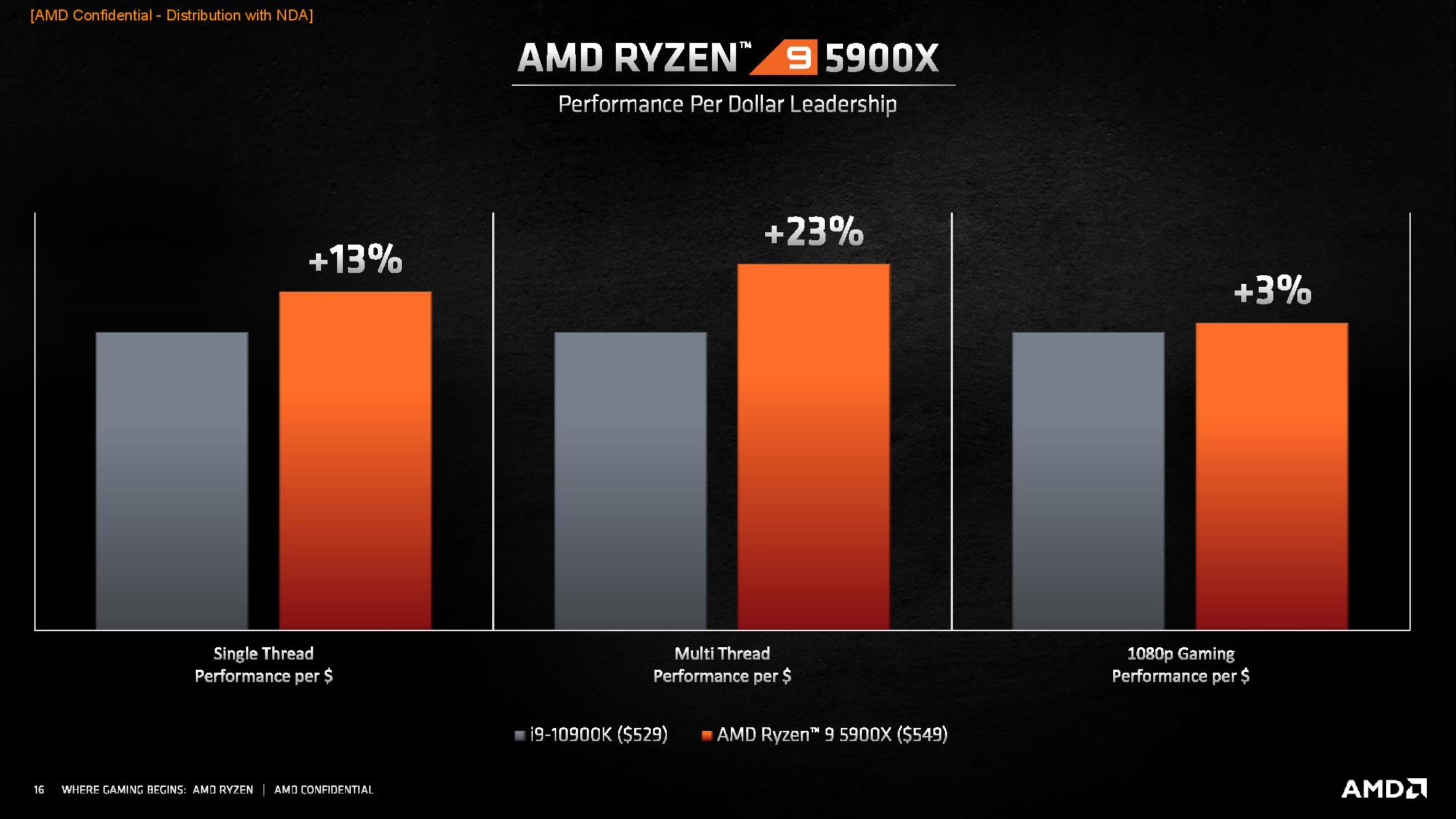
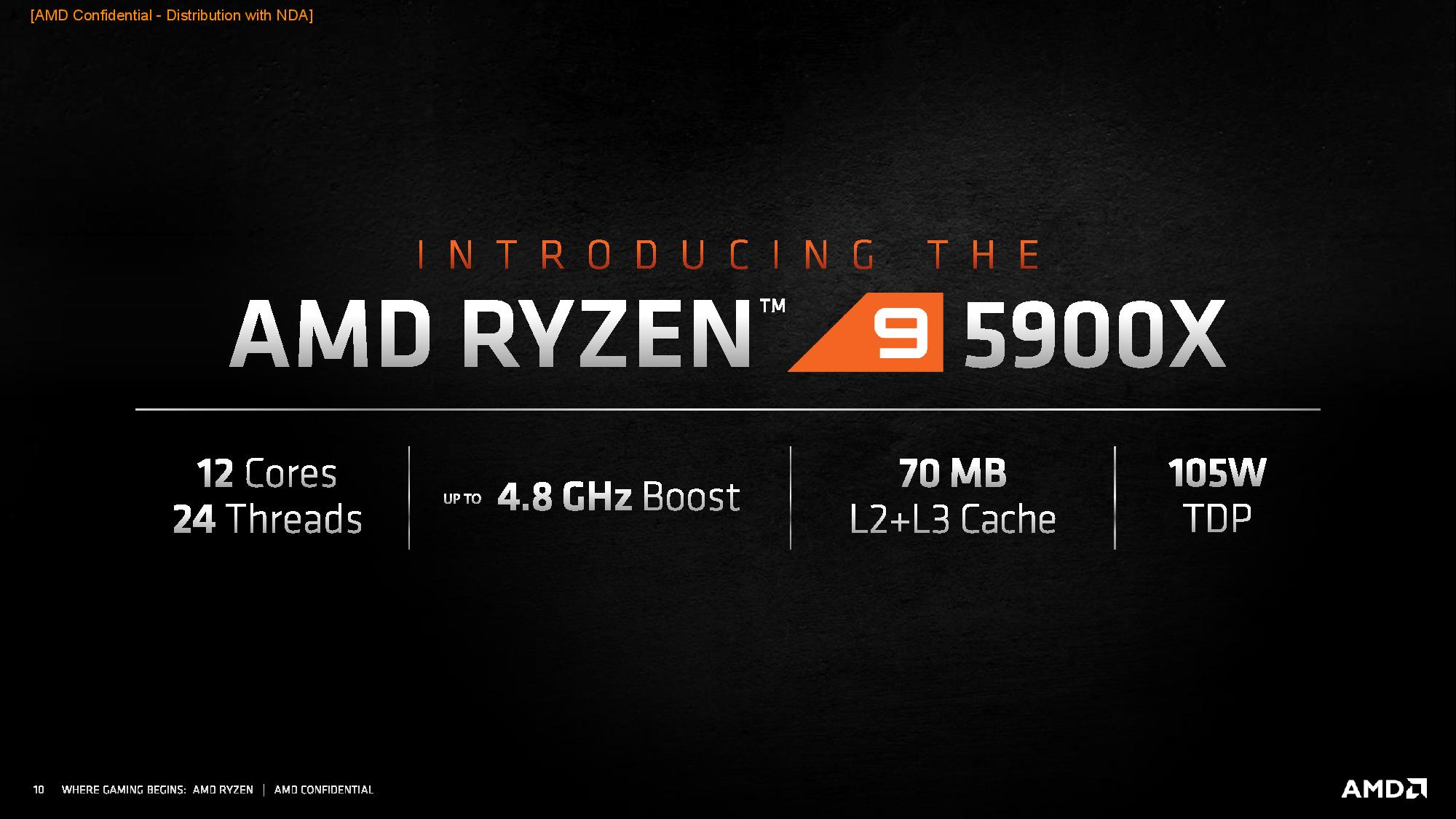
Here we see a spate of AMD’s 1080p performance benchmarks with the Ryzen 9 5900X up against the Ryzen 9 3900XT. Overall, the 5900X provides a 26% average fps performance improvement, which is pretty stellar for an in-socket upgrade. Notably, the processor notches higher gains in some titles — to the tune of 50% in League of Legends and 46% in CS:GO. Other titles, like Battlefield V and Total War, see low single-digit gains.
The second slide pits the Ryzen 9 5900X against the Core i9-10900K in a selection of games at 1080p with high fidelity settings. AMD recorded a slight loss in Total War, and some single-digit performance increases in a few titles. However, League of Legends and CS:GO, both of which are older titles, received significantly higher fps measurements.
We’ll obviously have to see these titles tested on our own test systems, and Intel could gain a bit more performance from overclocking. The jury is still out on Ryzen 5000’s overclockability, but the chips use the same process as the existing Ryzen XT models, so we don’t expect much headroom.
AMD Ryzen 7 5800X and Ryzen 5 5600X Performance Per Dollar Benchmarks
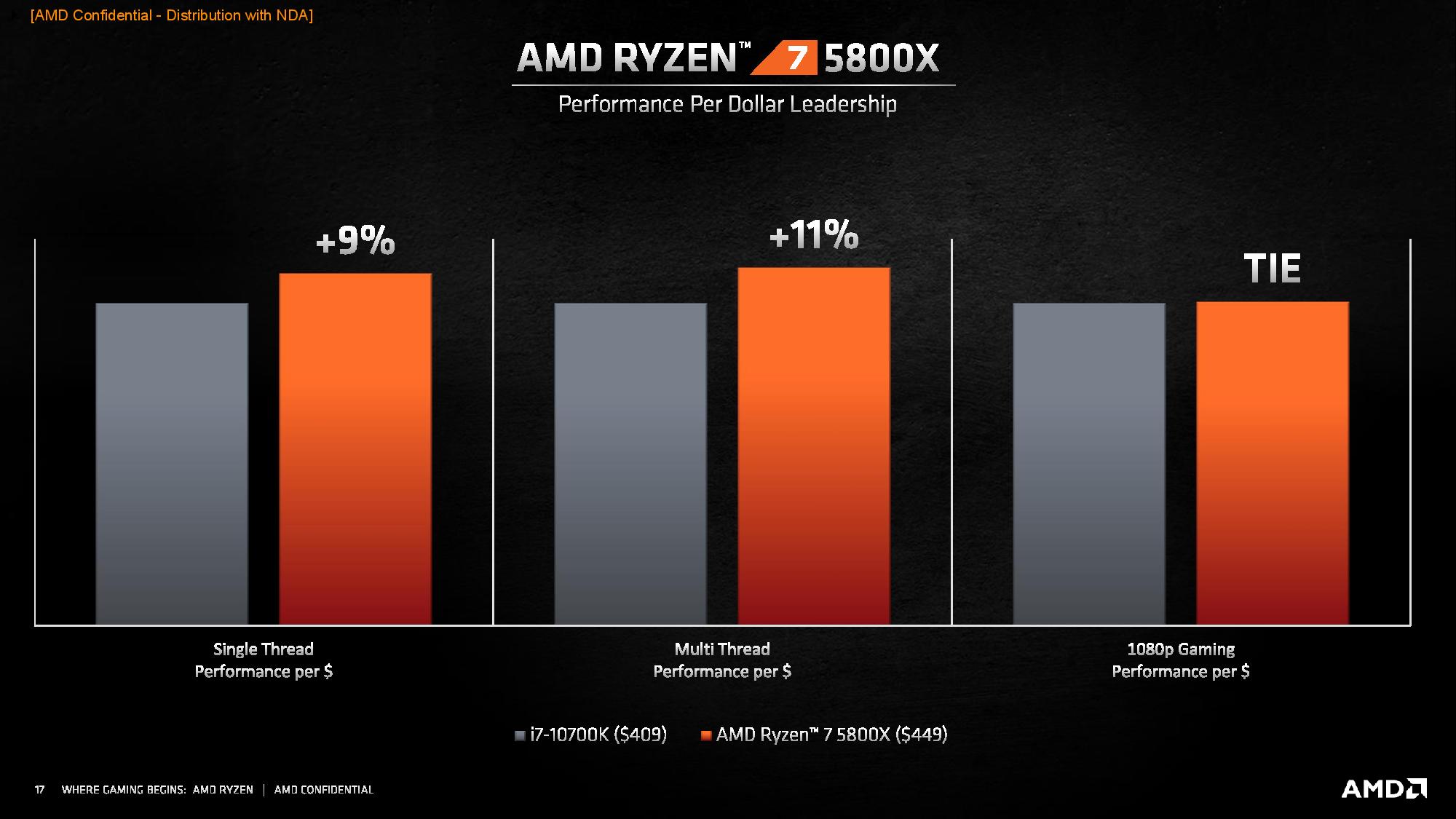
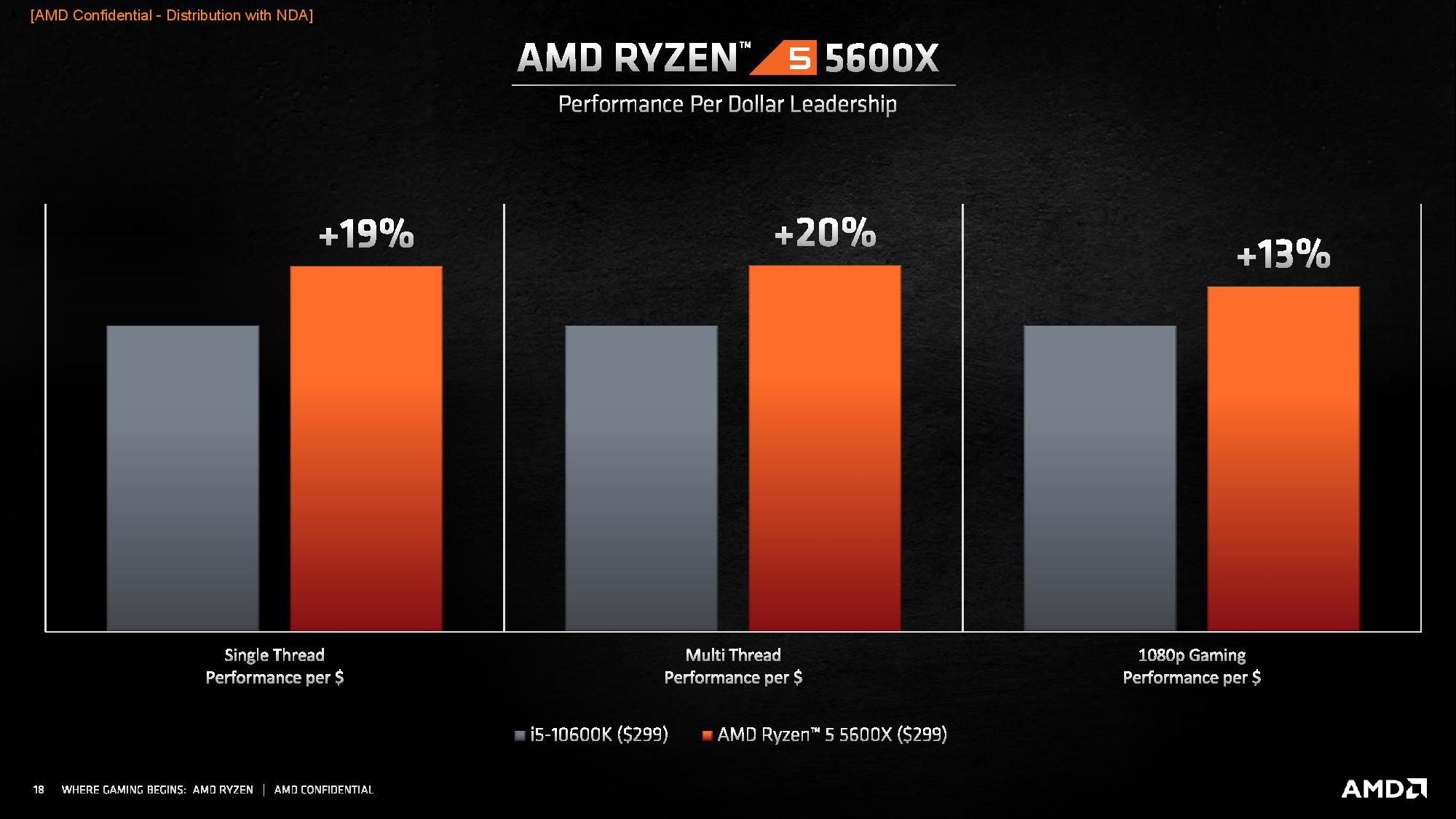
AMD didn’t share dedicated benchmarks for the Ryzen 7 5800X and Ryzen 5 5600X — the higher-end models are obviously in the spotlight for today’s announcements. However, the company did share performance-per-dollar slides, which you can see above.
Which Motherboards Work with AMD Zen 3 Ryzen 5000 Processors?
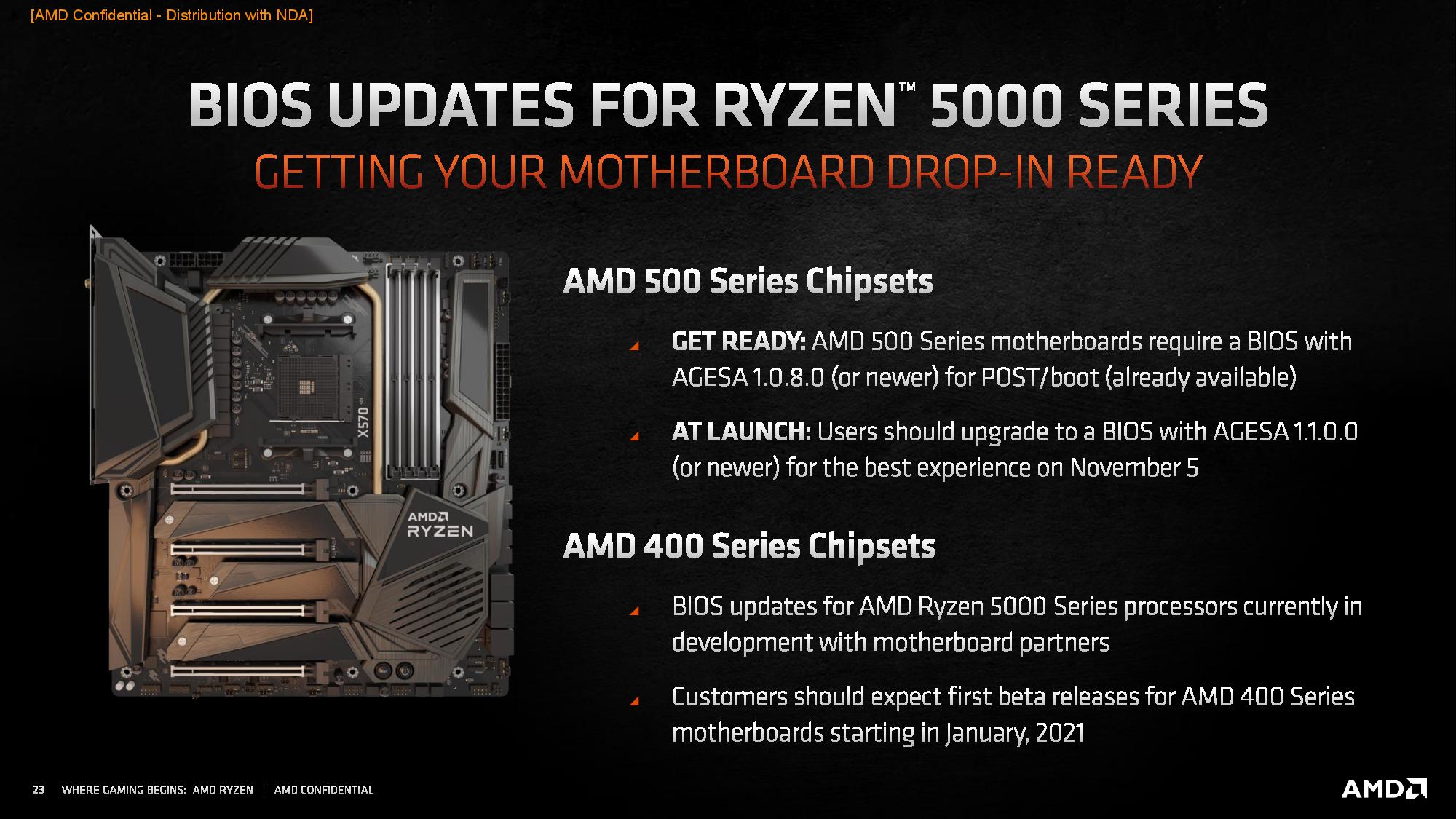
AMD isn't launching a new chipset with the Ryzen 5000 series; instead, the chips will drop right into existing 500-series chipsets. Existing boards require an AGESA 1.0.8.0 (or newer) BIOS to boot a Zen 3 processor, but AMD said those BIOSes have been shipping silently since summer. As a result, every 500-series motherboard on the market should have a downloadable BIOS available from the respective motherboard vendors. That means X570, B550, and A520 are covered.
While the early BIOS revisions ensure basic functionality, you'll have to update to AGESA 1.1.0.0 (or better) BIOSes for the best performance. These revisions are coming soon and will be available for all 500-series motherboards by the November 5th launch date.
AMD originally announced it wouldn't provide Zen 3 support for 400-series motherboards, but due to concerns from the enthusiast community, reversed course. True to its word, AMD will also provide support for 400-series chipsets, but development is ongoing, and those updates will come later. AMD says the first beta BIOSes will be available in January of 2021. However, a series of important restrictions apply to 400-series upgraders, which you can read about here. Note: You lose support for PCIe 4.0 on 400-series boards, but most gamers will not, and should not, care — it will make no meaningful difference in the short term for gaming.
We did see a few motherboards launch today with a Zen 3 focus in the branding, but those aren't required to run the new Ryzen 5000-series processors.
AMD Zen 3 Ryzen 5000 Microarchitecture
Now that you've seen the benchmarks, here's how AMD delivers its improved performance.
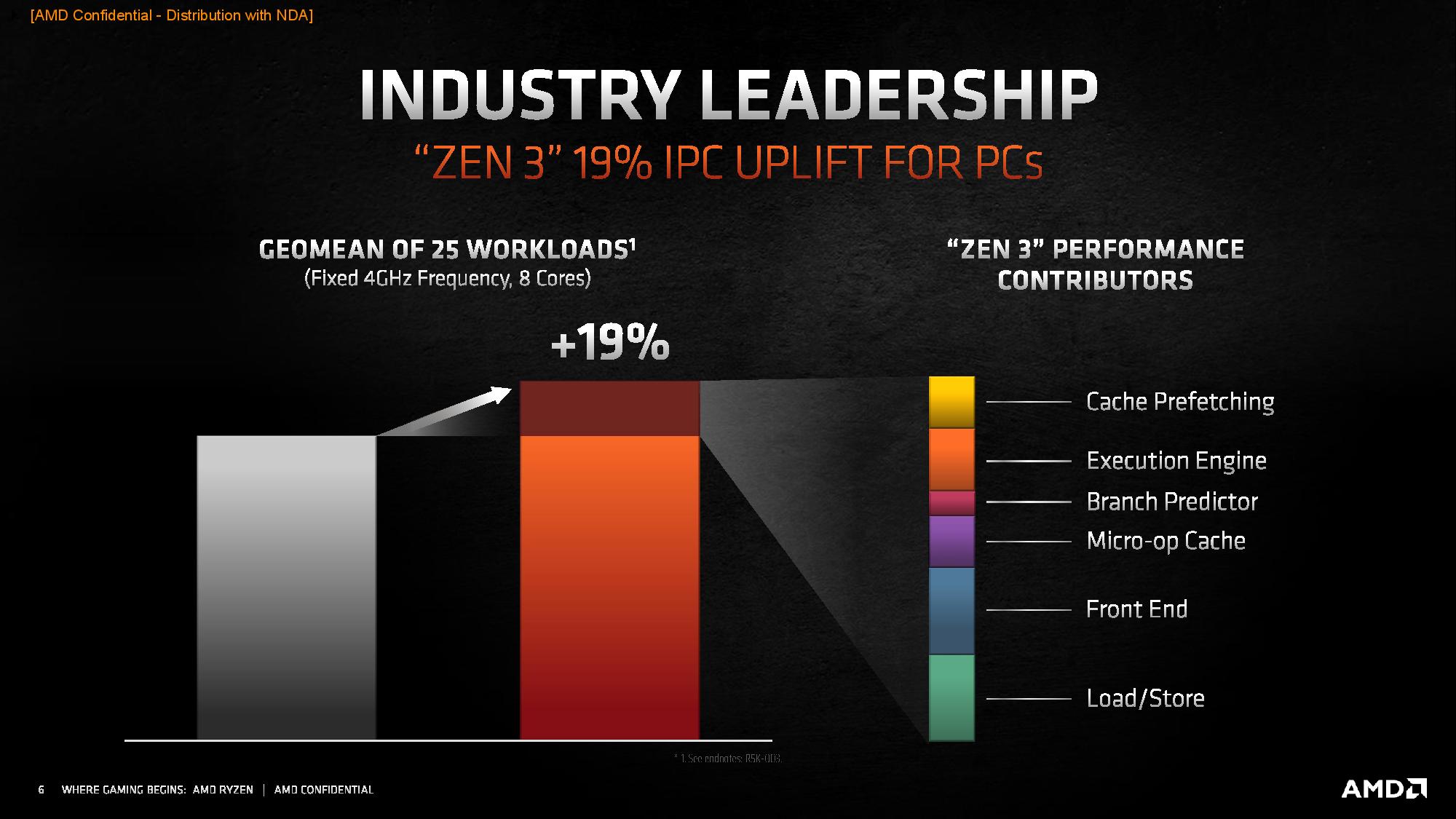


AMD shared many new details about the Zen 3 microarchitecture, but the company says it will share even more information in a future briefing.
AMD embarked on what it describes as a ground-up redesign of the Zen 2 architecture to deliver the types of gains we would normally expect from an entirely new microarchitecture. In fact, the company's ~19% increase in IPC represents its largest single-generation IPC increase in the "post-Zen" era (Zen+, Zen 2). We certainly haven't seen an increase of this magnitude for desktop chips from intel in the recent past, either — the initial Skylake architecture achieved a similar boost, but everything since has been nearly static.
AMD came to the 19% IPC number by calculating the geometric mean of 25 workloads measured with two eight-core chips locked at 4.0 GHz. Accomplishing the impressive IPC gains required a 'front-to-back' series of modifications to the design, including (but not limited to) the cache subsystem, front end, branch predictor, execution engine, and load/store elements, all with a focus on boosting single-threaded performance while wringing out better instruction level parallelism (ILP). The result is improved performance across the board in both single- and multi-threaded integer and floating point workloads. However, the 142W power limit imposed by the AM4 socket does restrict the scope of performance gains in some multi-threaded workloads.
On the process node front, AMD says it uses the same enhanced version of TSMC 7nm that it used for the Ryzen XT series, but still hasn't provided specifics. AMD still says it uses its 'special recipe' for 7nm, but specified that it doesn't use TSMC's 7nm+ (an EUV node). That means that AMD uses the standard N7 from Zen 2 with improved design rules, or that the chips use the N7P node.
AMD's end goal is to have 'undisputed best-in-class performance' in all workloads, and gaming performance was a particular focus, which brings us to the changed cache hierarchy.
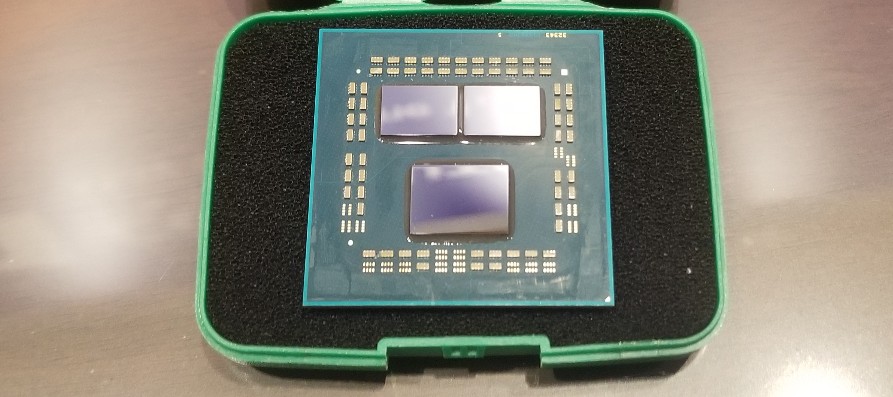
We caught wind of a big change to the Zen architecture a year ago via an accidentally-posted AMD presentation, and it is one of the most important changes to the design. As with the Zen 2 processors, Zen 3 uses the same 12nm I/O die paired with either one or two chiplets in an MCM (Multi-Chip Module) arrangement. In the image above, we can see the large I/O die and the two smaller eight-core chiplets.
Zen 3 Ryzen 5000 chips with six or eight cores come with one chiplet, while chips with 12 or 16 cores come with two. Again, this is the same approach AMD took with the Zen 2 architecture.
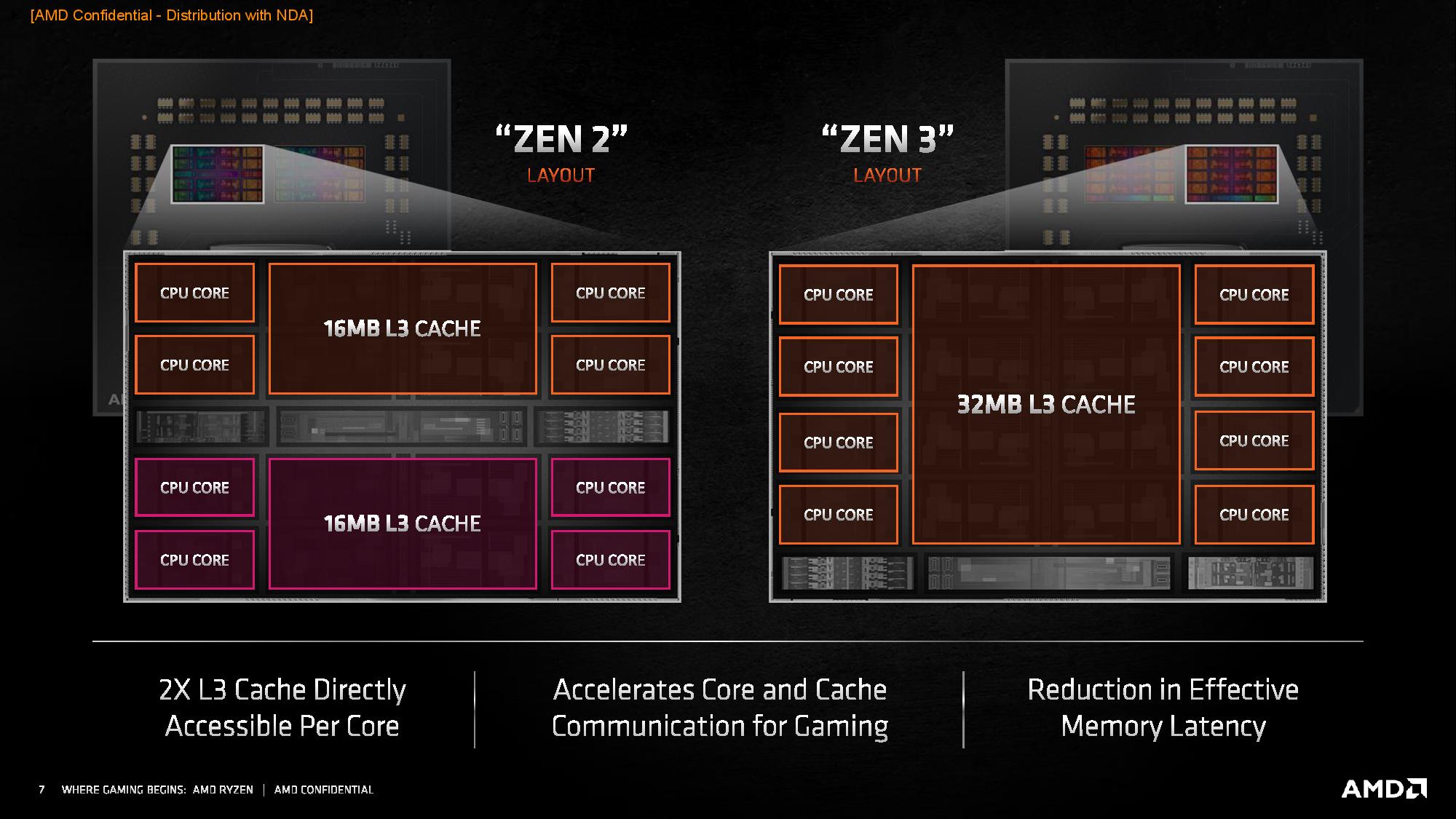
However, the internal design of each chiplet has changed dramatically. In the Zen 2 architecture (left), each Zen compute chiplet (CCD) contained two four-core clusters with access to an isolated 16MB slice of L3 cache. So, while the entire chiplet contained 32MB of cache, the split design meant that not all cores had equal access to all of the cache in the chiplet.
To access an adjacent slice of L3 cache, a core had to communicate with the other quad-core cluster by issuing a request that traversed the Infinity Fabric to the I/O die. The I/O die then routed the request to the second quad-core cluster, even though it was contained within the same chiplet. To fulfill the request, the data had to travel back over the fabric to the I/O die, and then back into the quad-core cluster.
On the right side of the slide, we can see that the chiplet now contains one large unified 32MB slice of L3 cache, and all eight cores within the chiplet have full access to the shared cache. This improves not only core-to-cache latency, but also core-to-core latency within the chiplet.
While all eight cores can access the L3 cache within a single compute chiplet, in a dual-chiplet Zen 3 chip, there will be times that the cores will have to communicate with the other chiplet and its L3 cache. In those cases, the compute chiplet's requests will still have to traverse the Infinity Fabric via signals routed through the I/O die, which incurs latency.
Still, because an entire layer of external communication between the two four-core clusters inside each chiplet has been removed, the Infinity Fabric will naturally have far less traffic. This results in less contention on the fabric, thus simplifying scheduling and routing, and it could also increase the amount of available bandwidth for this type of traffic. All of these factors will result in faster transfers (i.e., lower latency) communication between the two eight-core chiplets, and it possibly removes some of the overhead on the I/O die, too. We also imagine there could be other advantages, particularly in regards to main memory latency, but we'll wait for more details from AMD. We do know that the default fabric speeds haven’t changed, though.
All of this is important because games rely heavily on the memory subsystem, both on-die cache and main memory (DDR4). A larger pool of available cache resources can keep more data closer to the cores, thus requiring fewer high-latency accesses to the main memory. Additionally, lower cache latency can reduce the amount of time a core communicates with the L3 cache. This new design will tremendously benefit latency-sensitive applications, like games — particularly if they have a dominant thread that accesses cache heavily (which is common).
Naturally, power efficiency will improve as a function of reduced traffic on the Infinity Fabric, but that's probably a small fraction of the performance-per-watt gains AMD has extracted from the architecture. Increased IPC and other SoC-level optimizations obviously factor in here. Still, the net result is that AMD managed to stay within the same TDP thermal and electrical ranges as the Ryzen 3000 chips while delivering more performance.


AMD says it has not increased power consumption by a single watt — the maximum power draw for the AM4 socket still stands at 142W — which naturally will lead to impressive efficiency gains. AMD’s chart above uses the first-gen Ryzen 7 1800X as a comparison point, and here we see a 2X improvement by moving to the 7nm Zen 2 architecture. That isn’t too surprising considering the move from the older 14nm process to 7nm with that generation of chips.
The more important reduction comes from extracting more efficiency from the ‘same’ 7nm node, which is far more difficult and requires a combination of both better design methodologies and architectural improvements. As a result of these factors, AMD says it wrung out another 24% gen-on-gen efficiency improvement with the Ryzen 9 5900X over the Zen 2-powered Ryzen 9 3900XT. Again, that’s impressive. Intel's most recent Comet Lake chips had to increase power draw quite a bit and still had far lower performance improvements.
Thoughts

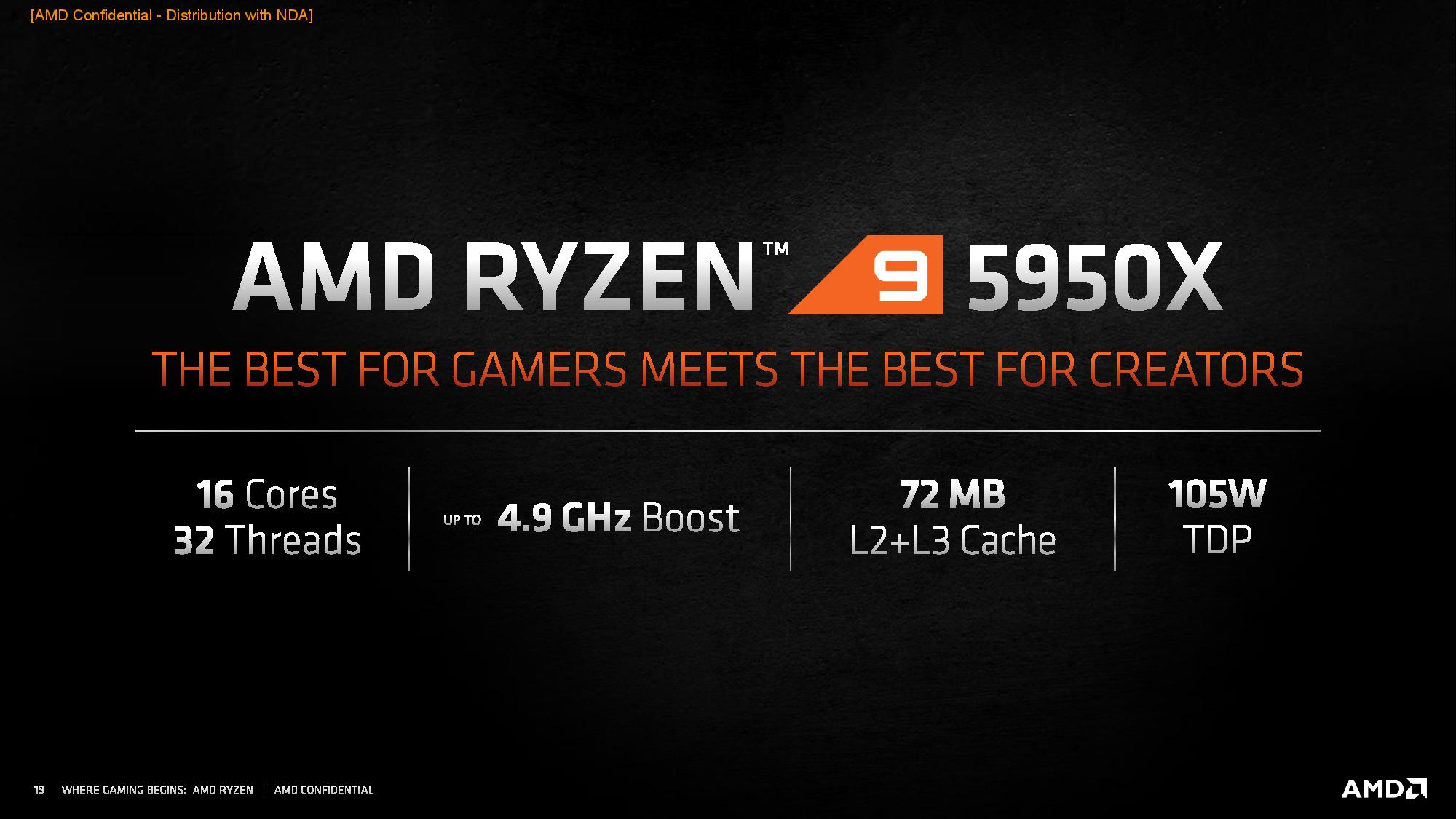
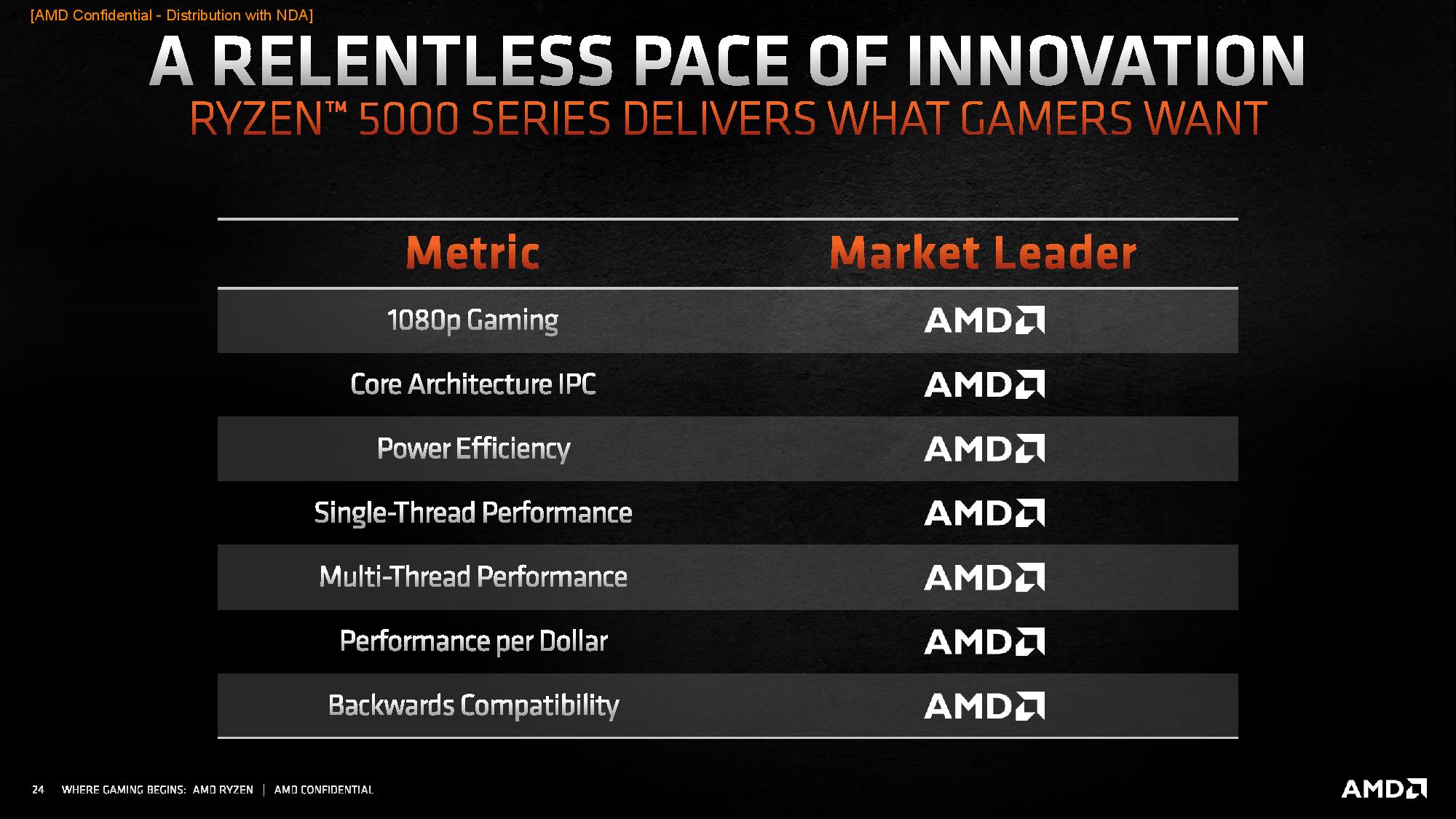
AMD’s Zen 3 is the fourth iteration of the Zen microarchitecture, and through a relentless cadence of on-time optimizations over the short four years that Ryzen has been on the market, it appears that AMD has finally stolen the performance crown entirely from the struggling Intel.
Even if AMD’s performance claims don’t pan out entirely, at worst, we may see performance parity in gaming in multiple positions in the product stack. But that’s actually all AMD needs — the company’s Ryzen processors already lead in just about every other metric that matters to enthusiasts. There’s just no getting around the power, cost, efficiency, and cooling advantages afforded by a smaller, denser 7nm process node that’s paired with the refined and mature Zen 3 architecture.
If Zen 3 lives up to its billing, it looks like AMD’s only constraint will be production capacity at TSMC. AMD will sell every Ryzen 5000 chip it punches out, at least until Rocket Lake arrives – and we still don't know if Intel’s new 14nm design can keep pace with AMD’s 7nm chips. AMD’s ecosystem of 500- and 400-series motherboard partners have plenty of relatively affordable options, so we don’t foresee any problems with motherboard supply.
On that front, AMD will undoubtedly meet with stiff demand for the Ryzen 5000 chips at launch, and the company says it is working with retailers to avoid the plague of purchasing bots that exacerbated Nvidia’s now-infamous Ampere launch. And AMD hasn't been free of shortages at launch either, with the Ryzen 9 3950X being relatively difficult to purchase for the first couple of months after it launched.
AMD’s announcement centers on the flagship chips, at least in terms of performance data, which is a good business decision. However, we expect that single-die Ryzen 5 and 7 processors will provide exceptionally good performance at their price points. Again, AMD’s ability to keep shelves stocked is of prime importance; the company has suffered from crippling shortages of its Ryzen 3 3300X and 3100 chips, which have been absent from retail since shortly after their launch five long months ago.
In terms of market share expansion, AMD’s Zen 3 chips will obviously enjoy unmatched uptake in the enthusiast and DIY segments, and the arrival of Zen 3-based APUs (for which there is no firm timeline yet) will broaden the appeal in the OEM market.
We also shudder to think what the Zen 3 architecture could be capable of when AMD drops it into its Threadripper lineup – Intel’s competing Cascade Lake chips are already embarrassingly overmatched in the HEDT segment, and our industry sources tell us that the next-gen Intel HEDT platform has been canceled. AMD hasn’t announced a timeline for next-gen Threadripper chips yet, but it’s unclear if there's a pressing need for them in light of Threadripper's already-commanding lead.
Intel does have it’s Rocket Lake chips waiting in the wings for launch in Q1 2021, but that’s long after the holiday season. It’s hard to imagine that prospective holiday shoppers will hold out for Intel’s Rocket Lake, regardless of whether or not it comes with Intel’s first new microarchitecture for the desktop PC for the first time in five years. In the end, Intel’s inability to economically produce 10nm chips for the desktop PC has caught up to it. Getting yet another 14nm chip (Rocket Lake) in 2021 just illustrates how far behind Intel has fallen.
As usual, we only have AMD’s marketing numbers to gauge the new chips for now, and the final proof is always in the silicon that lands in our labs. However, it’s hard not to be impressed with the Zen 3 reveal, and if Zen 3 lives up to its billing, we could see AMD enjoy a period of dominance that we haven’t seen since the Athlon 64 days.

Paul Alcorn is the Editor-in-Chief for Tom's Hardware US. He also writes news and reviews on CPUs, storage, and enterprise hardware.
-
JfromNucleon Wow, did not expect this, Intel might have to put a lot of effort to retake it's crown. Well competition is good for the consumer. (Though the price increase.........Reply -
RodroX ReplyJfromNucleon said:Wow, did not expect this, Intel might have to put a lot of effort to retake it's crown. Well competition is good for the consumer. (Though the price increase.........
Its always a good ideato wait and see what reviewers find out when they run thier own benchmarks, with the diferent settings, hardware, etc. But Ryzen 5xxx looks promising indeed.
One thing I like was the presentation itselt, it was sorta short and to the point, not going around stuff that no one really care, and way less inforcomercial style (thank God) than what nvidia did with the RTX 3000 series.
Now all we have to do is wait for independent reviews and see if reality meet expectations.
EDIT: Also it seems AMD is leetting go the Wraith cooler for the high end segment cpus. -
JfromNucleon Reply
One thing I noticed in the presentation was that the were not afraid to show a tie or even a negativeRodroX said:Its always a good ideato wait and see what reviewers find out when they run thier own benchmarks, with the diferent settings, hardware, etc. But Ryzen 5xxx looks promising indeed.
One thing I like was the presentation itselt, it was sorta short and to the point, not going around stuff that no one really care, and way less inforcomercial style (thank God) than what nvidia did with the RTX 3000 series.
Now all we have to do is wait for independent reviews and see if reality meet expectations. -
RodroX ReplyJfromNucleon said:One thing I noticed in the presentation was that the were not afraid to show a tie or even a negative
It was a nice touch, too nice indeed. We will see what happend when the reviews arrive. -
Giroro They eliminated equivalents to the overwhelmingly popular 3600 and 3700x, in lieu on the "pointlessly more expensive" 3600x and 3800x which performed nearly identically due to how the chips would almost never hit peak boost or base clocks.Reply
So the price hike is more like $100, not $50.
And that's over launch msrp for the 3600, not the current lower market prices.
I doubt the gaming uplift for the 5600x is good enough to justify a 50% higher price, even if it beats a stock 10900k, that's still a relatively minor performance delta in an uncommon use case. -
InvalidError Reply
Well, if the competition can tack price hikes on parts that only slightly outperform the former leader, then you don't have particularly effective competition. This looks more like what would happen in an oligopoly - raise prices at every opportunity and hope your only competitor follows.JfromNucleon said:Well competition is good for the consumer. (Though the price increase.........
I was thinking of upgrading my i5-3470 to a Ryzen 5600 before the announcement but at those prices, I'll wait to see what Rocket Lake pricing and performance will look like.
It is also a $90 hike over the current going price of a 3600X on Amazon.com.Giroro said:So the price hike is more like $100, not $50.
And that's over launch msrp for the 3600, not the current lower market prices.
Perhaps the main reason AMD decided to axe some of its most popular options and jack up prices at the same time is because it is severely short on 7nm wafer starts and needs to cool off demand until manufacturing can catch up. -
spongiemaster Reply
Both Intel and Nvidia usually stay away from comparing their products to products from other companies. That opens too many cans of worms and opportunities for complaining and nitpicking. When you're comparing vs your previous generation products, the new one really shouldn't ever be slower.JfromNucleon said:One thing I noticed in the presentation was that the were not afraid to show a tie or even a negative -
JfromNucleon Reply
Except for Intel on tigerlake launch, where they mentioned AMD more than their own productspongiemaster said:Both Intel and Nvidia usually stay away from comparing their products to products from other companies. -
RodroX ReplyGiroro said:They eliminated equivalents to the overwhelmingly popular 3600 and 3700x, in lieu on the "pointlessly more expensive" 3600x and 3800x which performed nearly identically due to how the chips would almost never hit peak boost or base clocks.
So the price hike is more like $100, not $50.
And that's over launch msrp for the 3600, not the current lower market prices.
I doubt the gaming uplift for the 5600x is good enough to justify a 50% higher price, even if it beats a stock 10900k, that's still a relatively minor performance delta in an uncommon use case.
AMD is launching this CPU in november 5, which does not mean this are the only 5000 series CPU they will launch.
Im guessing AMD just took a diferent approach to announce what they think they can deliver at this point, with a global pandemic going on. They are surely going to be building the silicon stock to launch new cheaper CPUs later on when the time is right.